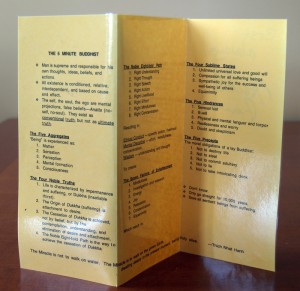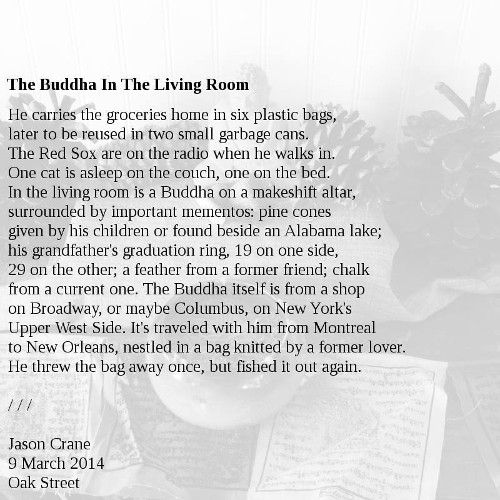
Category: Buddhism
This blog post by Nancy Thompson included Harold Ramis’s one-page form on Buddhism:
I thought some folks might like to print their own, so I recreated it. Download a PDF of the 5-Minute Buddhist.
2 Comments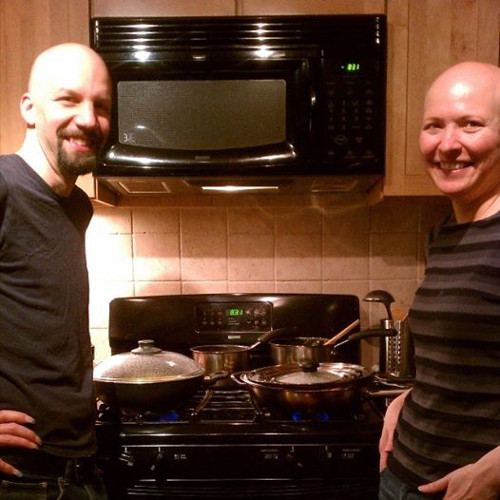
This weekend I stayed with my friends Daryl and Deborah in Brooklyn. On Saturday night they gave me the gift of a meal. And believe me, when Daryl and Deborah cook for you, it’s a gift.
Watching them work together in the kitchen was beautiful. First, it’s obvious how much they love one another and how much joy they take in preparing meals together. The whole process of cooking was like a partly choreographed, partly improvised dance. One person moving to the island in the middle of the kitchen to chop or read a recipe as the other moves to the stove to stir or add a bit of spice. One getting a bowl from the cabinet as the other pulls leaves off a stem. It was like watching a ballet where the story was being written by the dancers right there in the moment.
But what struck me even more was their attention to detail. Every part of the cooking process – deciding what to make and which dishes would go together, preparing the ingredients, cooking those ingredients, choosing the right serving containers and utensils – was carefully thought out, discussed, and agreed upon. There was a moment when Daryl and Deborah were picking exactly the right spoon for serving the chana dal, and I was overwhelmed with a sense of the love and joy and care that they put into meals and into taking care of their guests.
I’ve always appreciated people who care about the tiny details. Knowing the names of all the parts of a machine or the parts of speech or the intricacies of a piece of music. I once dated someone who said she only dated nerds, in other words, people who had at least one thing in which they were deeply interested. I still think that’s sound advice. Watching my friends cook brought that home. (Of course, the beautiful thing about D&D is that they bring that same level of passion and attention to many other things in addition to cooking.)
Being with Daryl and Deborah is inspiring in many ways. They’re a living lesson in mindfulness. I’m going to pay more attention to what they’re teaching.
Leave a Comment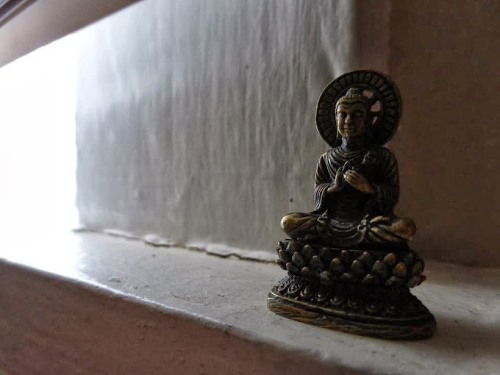
My plan for this New Year’s Eve was to travel to New York and take part in a midnight precepts ceremony at Dharma Punx NYC with my teacher, Josh Korda. I don’t have the money to do that, so I thought instead of taking the precepts with a sangha in person, I’d do it with a virtual sangha online.
The precepts might look, at first blush, like Buddhist commandments. I prefer to think of them as guidelines. There’s no punishment implied in violating them, other than the likely negative impact on your life and the lives of others.
There are many versions of the precepts, including long and complex versions for monastics. The version that resonates most with me is this list from the Rochester Zen Center, where I used to practice.
I thought it might be useful for me, as a way of setting my intentions for 2014, to go through each precept and refuge and talk about what they mean to me. Maybe it will useful for you, too.
THE THREE REFUGES
- I take refuge in Buddha. The reason Buddhism is meaningful to me is that the story of the Buddha is a story of something I, too, can achieve. It’s not a tale of magic and mysticism. It’s a practical set of actual practices that I can apply to my life. When I forget this, it helps to remember that Mr. Gautama, as he’s referred to in the Pali Canon, managed to figure it out 2,500 years ago.
- I take refuge in Dharma. The dharma is the system outlined in Buddhist texts for getting past our craving and desire. For me, a key component of this is my meditation practice, which has become a daily part of my life after years of on-again off-again dabbling. There’s a lot more to the teachings than this, but meditation is a great place to start, and it’s a practice I intend to continue.
- I take refuge in Sangha. This has always been the least regular part of my practice. Except for a few brief periods, my Buddhist practice has been a very solitary thing. Now I’m working with a teacher and feeling more connected to his sangha. I’m also going to work on gathering a meditation group of my own in 2014. Not one where I serve as a teacher, of course. Just a group of people who get together once a week to sit.
THE THREE GENERAL RESOLUTIONS
- I resolve to avoid evil. This and the next resolution are simple yet form the core of the idea of non-harming (ahimsa in Sanskrit). It’s impossible, of course, to avoid harming others, either through direct action or through the things I buy or eat or the systems I take part in. So the goal is to reduce harm as much as possible.
- I resolve to do good. For me, this is the most powerful of all these statements. “I resolve to do good” is an affirmative statement of my intention to make the world better. “The world,” in this case, could mean my life with my children, my workplace, my own mental and physical health, my community — the possibilities are endless. I feel like I’m not doing enough with my skills to make the world better, and I’d like to get better at that in 2014.
- I resolve to liberate all sentient beings. In the words of Douglas Adams, “this is, of course, impossible.” This resolution is less about a concrete thing I plan to do than a restatement of the idea that doing good has many contexts, and they don’t stop at homo sapiens.
THE TEN CARDINAL PRECEPTS
- I resolve not to kill, but to cherish all life. I’m renewing my commitment to being vegan in 2014. I became a vegan in 2010 and have stopped twice since then, once during my 2012 tour and again for the past several months. It’s time to get back to eating ethically. I also plan to continue my Stink Bug Catch And Release Program in 2014.
- I resolve not to take what is not given, but to respect the things of others. On the face of it, this means I’m not going to steal, but I don’t steal anyway. Looking deeper, it could also mean I’m going to try to use as few resources as possible, since almost all use of resources means depriving someone else of them. I could also interpret this to mean being careful of others’ feelings and being sure not to assume more of others than they’re able to give.
- I resolve not to misuse sexuality, but to be caring and responsible. I was married from the age of 22 until I was 37, and sexuality was not a big part of that. In recent years, I’ve discovered a whole new side of myself both emotionally and sexually, and with that have come pitfalls that are probably obvious to more experienced people but sure weren’t obvious to me. I’m going to stick close to this precept in 2014.
- I resolve not to lie, but to speak the truth. Another seemingly simple precept that contains worlds. In my case, I find it fairly easy to be honest with others. The trick is to be honest with myself. To speak the truth to myself about what I need and what I need to change or work on. I also plan to speak more truth to power in 2014.
- I resolve not to cause others to abuse alcohol or drugs, nor to do so myself, but to keep the mind clear. Having never had a drink or a drug in my life, I’ve also found this one a bit of a slam dunk. And I hope I haven’t driven others to drink or use drugs. I don’t think I have.
- I resolve not to speak of the faults of others, but to be understanding and sympathetic. This is a hard one. I love to gossip, even though I feel guilty while doing it. I will try to do a lot less of this in 2014.
- I resolve not to praise myself and disparage others, but to overcome my own
shortcomings. I very rarely praise myself. In fact, for the sake of my career, I should probably do it more. But seriously, I do find it easy to be critical of the world at large. I could spend more time turning a critical eye on myself. Not a disparaging eye, but one aimed at self-improvement. - I resolve not to withhold spiritual or material aid, but to give them freely when needed. I love this precept. Remembering to be such a person to my family, friends and strangers is so important. I rely on my friends for emotional support and hope to be someone they can rely on, too. The same for my kids.
- I resolve not to indulge in anger, but to practice forbearance. I don’t get angry often, but I do get annoyed or irritated at things that don’t matter at all. My meditation practice helps me avoid this and I look forward to strengthening those skills. That said, I find righteous anger a useful tool when it comes to changing the world, and I’m going to hold on to that.
- I resolve not to revile the Three Treasures (Buddha, Dharma and Sangha), but to cherish and uphold them. I’ve never been sure about who might revile the Three Treasures, and I don’t feel like it’s a trap I’m going to fall into. But the latter part, about cherishing and upholding them, feels to me like a useful closing of the circle of these precepts.
Thank you for reading this, and for helping me to live up to these ideals in 2014 and beyond. I wish you love and happiness and peace and justice. Happy New Year!
2 Commentssay I’m a Buddhist
say “I’m a Buddhist”
not to identify your-
self to others but to
identify yourself to
yourself
5 December 2013
Oak Street

ending
the flame is hot and bright
at the tip of the incense
it looks miles above the pot
of white ash waiting below
a puff of air through pursed lips
brings forth the smoke
and the smell of winter nights
on tatami floors, hot mugs
of green tea fitting
perfectly in cold hands
further down now, the ember
no longer glows, but
the smoke is heavier in the air
it catches the beams of the
autumn sun through the
narrow kitchen window
this is the time to sit quietly
to follow the breath
to be aware of the sounds
of cars on the street
wind in the bathroom vent
the stick is burned down
nearly to the bed of ash
it doesn’t know, of course
that in a moment it will end
its brief flame snuffed out
nothing left but the lingering
scents of clove and cinnamon
captured as tiny grains floating
in the last rays of sunshine
10 November 2013
Oak Street
smoke from a new stick of incense
fills the cold room
with the scent
of a Japanese temple
or the small room
on the second floor
I used to meditate in
the one I had to unlock
with a kitchen knife
9 November 2013
Oak Street
Thay

(for Thich Nhat Hanh)
his voice
a low, reedy
instrument
filling the hall
just a few notes
hard d’s and t’s
like punches
“we need the
mud [punch]
to make the
lotus” [pause]
someone rings
the deep bell
he waits for it
to fade away
26 October 2013
Oak Street
o-bon
flickering paper lanterns
carry handwritten messages
four children at the water’s edge
pull leaves off the top of the pond
the deep rumble of a drum
bounces off the hillsides
while we watch the lights
each keeping our own counsel
6 October 2013
Julian Woods, PA

Ikkyu in the brothel
a Zen monk who said “pussy”
(at least in translation)
and talked about giving head
who went from temple to bar to brothel
naked and drunkenly laughing
finding no-self in other’s bodies
he’s a bucket of water in the face
of our culture with its return to
Puritanism and the Old Testament
light some incense!
take off your clothes!
make someone come!
9 September 2013
State College, PA
the problem with non-attachment
“You can sit
and stare at
the wall all
you want,”
David said,
“except that
we all, at the
core of our
being, need to
be attached
to someone.”
8 September 2013
State College, PA

on the Black Moshannon
a flotilla of water lillies
floating on the Black Moshannon
each one a seat for a deity
my son picks one white flower
brings it into the canoe
droplets falling off the petals
the sound of our hull
as it strikes the lily pads
is like metal on metal
later, as we stop beside the dock
Jen and I hold the boat stable
while our sons step back onto land
7 September 2013
State College, PA
Over the years, people have asked me what I do when I meditate. This is what I do:
1. Find a quiet space. One where no one else is, and one where you can’t hear music or roommates talking or the TV.
2. Get a couple pillows. The goal is to sit on them so your rear end is a few inches above the ground. This helps you maintain a good posture and helps your knees touch the floor when your legs are folded.
3. Sit in one of three positions:
full lotus
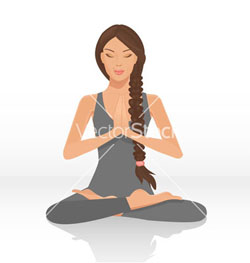
half lotus
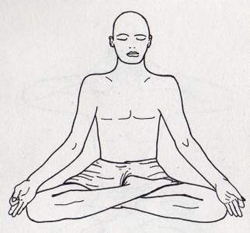
Burmese
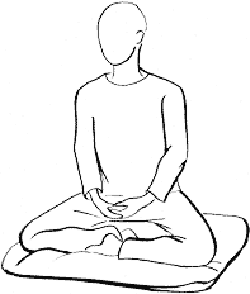
I use Burmese, which is the easiest of the three.
4. Put your hands in front of you about waist-high like this:
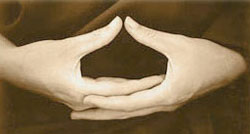
5. Balance your weight over your hips. Imagine a string running up your spine and pulling you toward the ceiling. The point of all the previous steps is to create a self-supporting posture so your body will keep itself upright without you having to expend much energy.
6. Look at a spot a few feet in front of you on the floor. Some people close their eyes all the way. I don’t. If you keep your eyes open, keep them in focus, too. Not staring, but not wildly fuzzy. Just a normal gaze.
7. Breathe in and out at a regular pace through your nose. You can do just this, or you can count your breaths (in “one,” out “two” — till you get to “ten” then start over; if your mind wanders and you lose count, just start at one again).
8. Don’t try to clear your mind or any of that, just let the thoughts come and go. At first, this will seem maddening. Everyone’s brain is active, including mine and including yours. I still have days where my mind is bouncing all around. But I also have days when it isn’t. Notice your thoughts and let them happen, but try not to follow any one thought down the rabbit hole.
9. Try to do this whole thing for 5 minutes the first few days. Then 10. Then, if you can, get yourself up to about 20 minutes a day. First thing when you get up or right before you go to bed. Or both.
10. As of today, I’ve gone 298 days without missing a day. (And, with the occasional missed day, I’ve been doing it for much longer.) This last year has been one of huge upheavals in my life, and I’m convinced meditation has helped me maintain some level of sanity through it all.
11. Meditation is never perfect. If you don’t have a quiet space at home, do it under a tree or on a park bench or anyplace you can grab a little alone time. The library is perfect — you can meditate in a chair and it’s always quiet.
Leave a Comment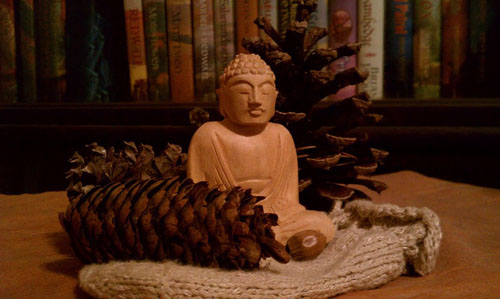
A new friend asked me yesterday whether I’m a Buddhist. I always have a hard time answering that question.
The evidence in favor: I have a daily mediation practice. I meditate in a room with a small shrine that includes a Buddha statue. I read a lot of Buddhist literature. I wear a mala bracelet (although I’m not a Buddhist in the Tibetan tradition; I just wear it as a reminder) and a necklace with an image of the Buddha. I have a copy of the precepts tacked to the wall in my bedroom. When I was on tour last year I carried a Buddha statue with me and took lots of photos of it.
The evidence against: I don’t have a sangha (a group of people with whom I practice). I don’t have a teacher. I don’t belong to any particular sect. I’m an atheist who is reluctant to self-identify with something many folks consider to be a religion.
I should point out that one of the reasons I don’t have a sangha or a teacher is because it’s hard for me to find one of either that fits my needs. I can’t stand the quiet-voiced teachers who populate so many Buddhist centers in the U.S. (Think Bob Ross in robes.) People like that, rather than inspiring equanimity, make me want to punch them. I think that’s why I find Josh Korda from Dharma Punx NYC so refreshing. If I could have any teacher, it would be him. (You can hear him for yourself here.)
And there’s a lot of wealthy white privilege in American Buddhist centers, but, in my experience, not a lot of acknowledgement of that fact or action in the outside world. I’m painting with a broad brush — there are certainly counterexamples. The Buddhist Peace Fellowship, for instance.
But despite all that, I recently updated my Facebook page to read Buddhist Atheist. (I know, I know.) Because for some reason it matters to me to be identified with other people who are walking this same path. Even though “Buddhist” can mean anyone from folks like me all the way to people who believe in demons and spirits and magic and such.
Whenever I write a post like this, I imagine a few of my oldest friends shaking their heads in sadness at my passage to the woowoo side. And some part of me feels the same way — like my need for group identification or membership is a sign that I’m not strong enough on my own.
That usually passes quickly, though, when I think of all the benefits that my practice has brought to my life. Simply put, I’m a better person because of it. I’m able to understand my emotions more fully, to gain a split second of time before I react to something, and to pay closer attention to my world and the people in it.
And there’s something about Buddhism in its basic form that I find very appealing. It speaks to the need to find peace and understanding in my daily life, and provides a way to do that. I’m sure it’s possible to use similar methods without the trappings of thousands of years of Buddhism, but I find them comforting and inspiring.
One of the books that made me more comfortable with Buddhism was Confession of a Buddhist Atheist by Stephen Batchelor. It helped me strip away the things that make me uncomfortable and adopt what, at least for me, is an essential Buddhism. Others might disagree, but Batchelor’s books have been a great help to me.
So yes, I guess I’m a Buddhist. And while that’s not the most affirmative way to put that, it seems like the right way to say it.
/ / /
p.s. — My friend Carmen once said to me, “All I can say is that if you call yourself a Buddhist you aren’t one.” She’s brilliant, but I hope she was wrong.
12 Comments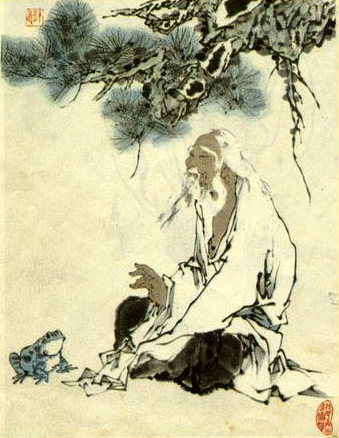
rowboat
you are in a rowboat
floating
on the surface of a
still
pond
I am swimming toward you
slowly
steadily
I am not trying to surprise you
but your eyes are closed
so you don’t
see me
coming
when I reach your boat
I grab the side
to pull myself in
you sit up
startled
but I was so peaceful, you say
I’m sorry, I say
I just wanted to share it with you
16 April 2013
Auburn, AL
/ / /
This poem is very loosely based on this famous parable by Zhuangzi. As retold in this dharma talk by Josh Korda.
Leave a Comment